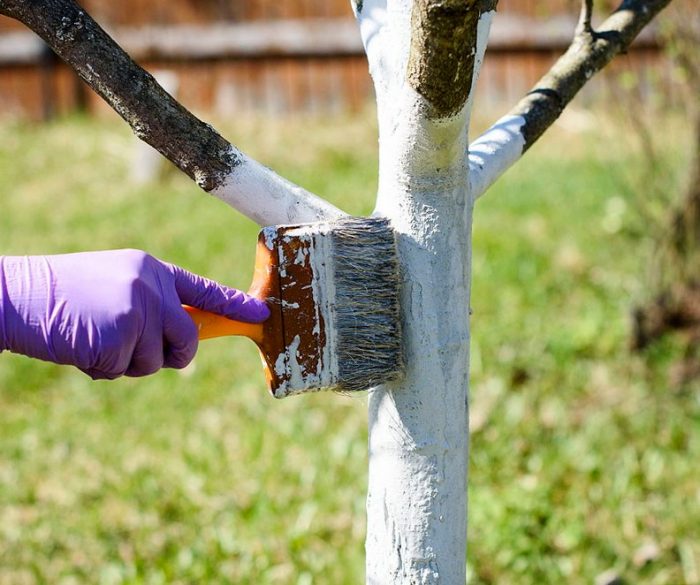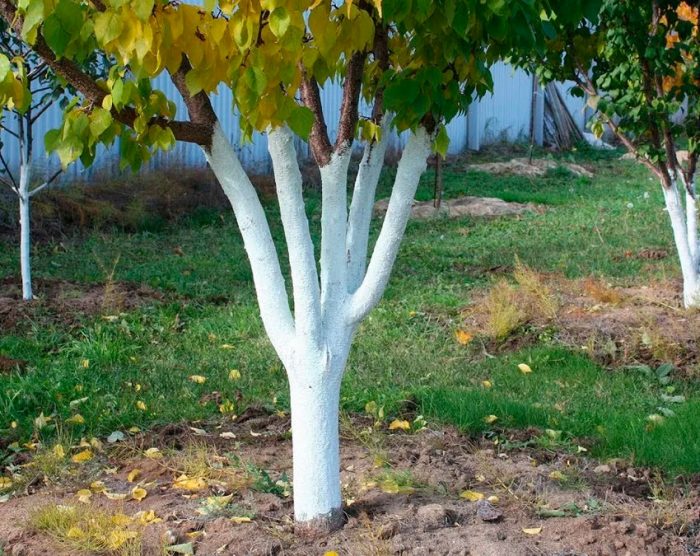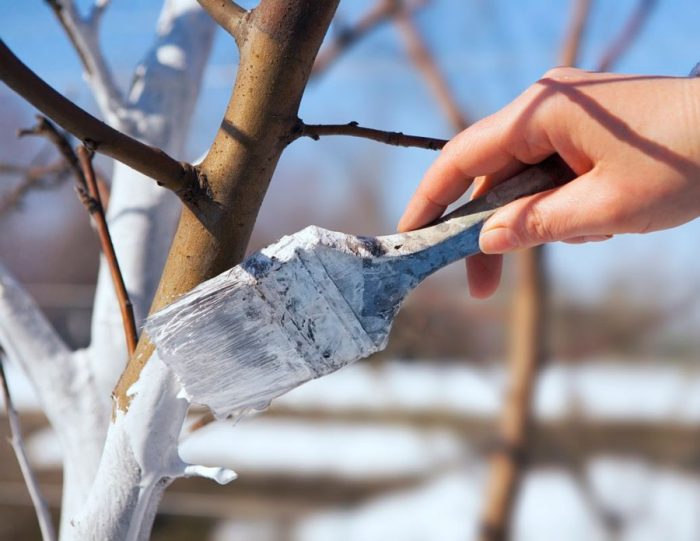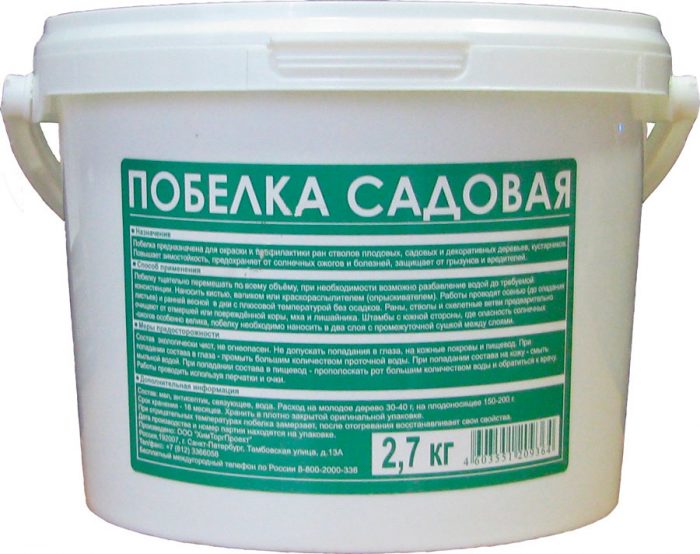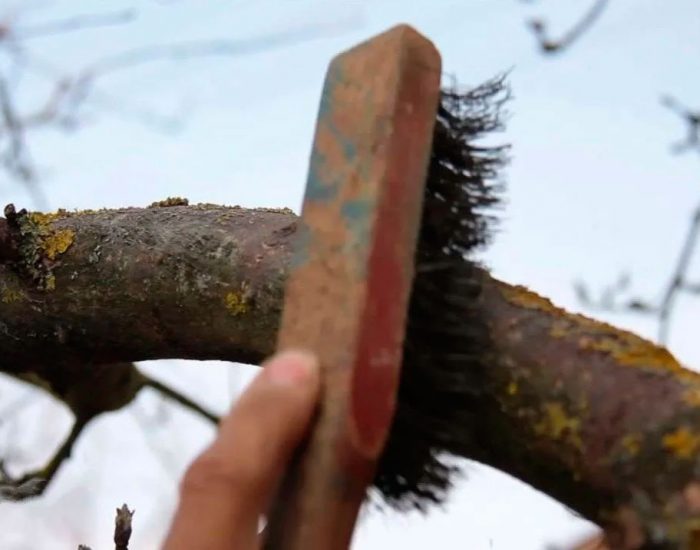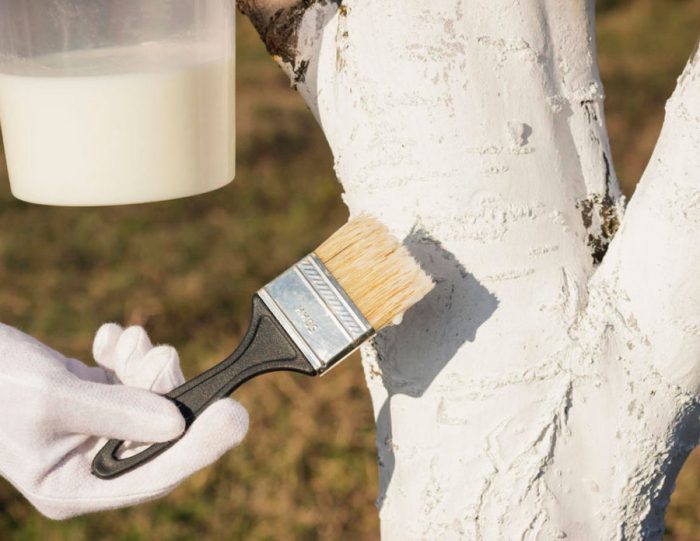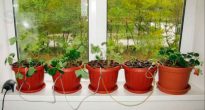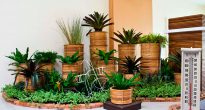Probably everyone saw how the trunks of fruit trees were whitened in early spring or autumn. However, few people know why they do this? Someone thinks that whitewashing the trunks is necessary to increase the decorativeness of the plant, while others think that it is needed to protect the tree from diseases. Who is right?
Content
Why whitewash trees
The bark is a kind of protective covering for trees. It is she who suffers primarily from various changes in the external environment, for example: from the scorching rays of the sun, frost, sudden changes in temperature, cold strong winds, from rodents and other pests, etc. Under the influence of unfavorable external factors, the crust eventually becomes very rough, cracks and may peel off. To make it clearer, just compare the rough, cracked surface of an old plant and the smooth, thin skin of a young tree.
Since the bark of trees takes the first blow, it is imperative to monitor the condition in which it is. Moreover, with regular whitewashing of tree bark, it will be reliably protected from:
- sunburn in winter and spring, because at this time there are no leaves on the plant, and its stems and trunk are defenseless against the scorching rays;
- sharp changes in temperature, due to which cracks appear on it;
- frostbite;
- from harmful insects that settle in the bark.
That is why every experienced gardener knows that whitewashing trunks must be approached with great responsibility. At the same time, remember that it is necessary to whitewash not only fruit trees, but also decorative ones.
When to whitewash trees
In autumn
Experienced gardeners say that it is necessary to whitewash trees 2-3 times a year: at the beginning of the spring period, as well as in the summer and autumn. In this case, the main whitewashing is carried out in the fall. The best time for this procedure is October or November, shortly before the first frost. Autumn whitewashing helps to protect plants from harmful insects and pathogenic fungi that have gathered to winter in the bark. In addition, the whitewashed trunks will be protected from ice formation, and hungry rodents will bypass them.
In the spring
In the event that the trees overwintered unbleached, then whitewashing will need to be done in late winter or early spring. This is best done in February. The fact is that at the end of winter in the daytime, unbleached trunks can be heated by the scorching rays of the sun up to 11 degrees. And this can lead to the beginning of sap flow.However, in February at night, the air temperature can still drop to minus 10 degrees, so the juice can freeze. As a result, the rupture of plant tissues and the formation of frost holes are often observed, which are deep and large cracks in the bark. If there is a white coating on the surface of the trunk and the base of the skeletal branches, then it will reflect the rays of the sun. Thanks to this, the bark will not heat up, as a result of which the sap flow will not start ahead of time and frost breaks will not appear. If the trees were whitewashed in the fall, then it is recommended to refresh the whitewashing in the spring. In this case, it is held in February – March or in the first days of April.
Do trees need summer whitewashing? In the event that the whitewash from the trees was washed away by heavy rains, experts recommend that it be refreshed in the summer. But if the trunks are covered with a stable compound that is very difficult to wash off, then you do not need to whiten them in the summer. Remember that you need to whitewash trees at any time of the year on a fine day when there is no rain or snow.
How to whiten trees in autumn
Preparations for whitewashing trees
For whitewashing trees, water-dispersion or water-based paint, as well as a lime solution, are most often used. The composition of the solution used for whitewashing must necessarily include the following components:
- lime or chalk, since the color of the solution should be white in order to scatter the scorching rays of the sun;
- so that the solution adheres better to the surface of the tree, clay or glue is added to it;
- a fungicide is used as a disinfectant, with copper sulfate being the most popular.
Lime solutions are quite popular among gardeners. Despite the fact that this tool has been used for whitewashing trees for a long time, has a simple recipe and a relatively low price, it has one significant drawback - it is washed off very quickly. To prepare a lime mortar, you will need to mix half a bucket of water with 1.25-1.5 kg of slaked lime or chalk, 0.25 kg of copper sulfate and 50 g of casein glue (can be replaced with a few tablespoons of flour paste). Stir the composition thoroughly until all the components are dissolved and mixed together. Then the solution is left alone for a while so that it can infuse.
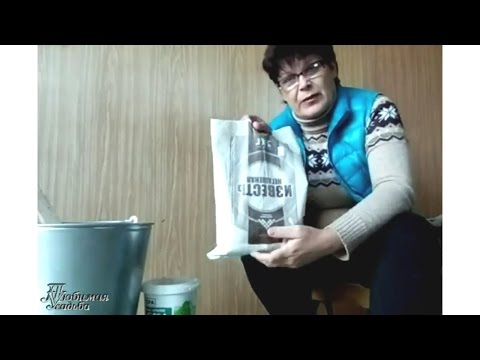

Watch this video on YouTube
However, this is not the only recipe for lime mortar, there are several more:
- Dissolve one kilogram of lime and manure in eight liters of water, and add 0.2 kg of copper sulfate. Mix everything well and leave the mixture for 2-3 hours to infuse.
- At the beginning, 0.4 kg of copper sulfate is mixed with hot water, which needs very little. After that, the solution is mixed with a couple of kilograms of slaked lime and 1 bucket of water. Add 60 to 100 grams of casein glue to the mixture. This mixture is characterized by relatively high stability.
- A couple of kilograms of slaked lime, one kilogram of oily clay, 0.25 kg of copper sulfate and one shovel of cow dung are dissolved in one bucket of water. The mixture should be infused for 2-3 hours.
Garden water-based paint does not harm trees and is durable. It covers the surface of the wood with a layer that is not washed off with water, is resistant to direct sunlight, and also allows air and moisture to pass through.
Garden water-dispersion paint includes not only pigment, but also latex, antiseptic, and various modifying additives. Such a coating is good for air permeability, but at the same time it protects the bark from harmful UV radiation, which can cause significant damage to the plant in winter and early spring. In addition, such a tool creates a durable coating that stays on trees for about two years. Coating of trunks with such a composition can be carried out only if it is not colder than 3 degrees outside.
For whitewashing fruit trees, you can use a mixture prepared by your own hands, and you can take a bustilate or other glue that contains latex as a basis. To prepare the solution, combine chalk or kaolin with a binder (PVA glue or busylate) in a 1: 2 ratio. Mix the ingredients well, then gradually pour water into the mixture. As a result, the resulting mixture should have the consistency of oil paint.
Whitewashing equipment
Not so long ago, sponge brushes were widely used to whitewash tree trunks. But today, flat paint fly brushes made of artificial bristles, bristle brushes or flute brushes are gaining more and more popularity among gardeners. They cover both smooth and rough surfaces with the same quality and quickly. Therefore, these brushes are very easy to use and allow you to finish your work faster.
There are gardeners who find it more convenient to use paint rollers. However, if there are a lot of trees in your garden, and they are quite large, then it will be much more convenient and faster to whitewash them with a spray gun.
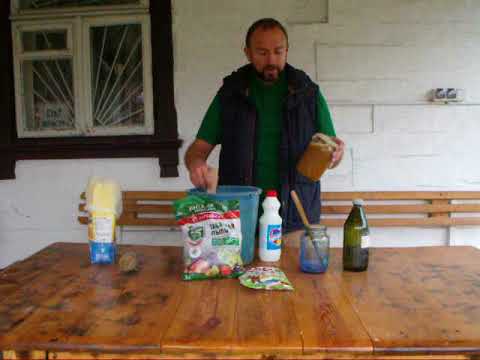

Watch this video on YouTube
How to whiten trees in autumn
Preparing trees for whitewashing
In that case, if the trees were whitewashed only for beauty, then it would be possible to simply cover the trunks with lime mortar or special paint to a height of 100–120 cm. But the benefits of such whitewashing would be insignificant.
Remember that you should cover with paint or lime not only the entire bole, but also the lower part of the skeletal branches (1/3 of their length). Mature trees are usually covered with garden paint or lime mortar to a height of 180 to 200 cm. However, before you start whitewashing, you should start preparing the trunks. Choose a damp day for this and clean the trunk and the bottom of the skeletal branches from moss, lichens, as well as old bark that has already peeled off. You need to clean the trunk only with your hands, which should be protected with gardening gloves made of dense material. It is highly undesirable to use washcloths, scrapers, plastic or metal brushes for this, since you can easily injure healthy bark with them. All depressions and cracks in the bark must be well cleaned with a pointed peg or a knife made of wood.
Everything that you removed from the tree trunk during cleaning must be destroyed. After this, the cleaned bark should be disinfected. To do this, they choose a calm, fine day, since the rain will simply make all the work you have done useless. Trees are disinfected with a solution of copper sulfate (3-5%); for its preparation, add from 0.3 to 0.5 kg of the substance to 10 liters of water. If desired, you can replace copper sulfate with such means as Oxyhom, Bordeaux mixture, HOM or Abiga-peak. The trunks are treated with a disinfectant composition using a fine sprayer at close range. Please note that during processing, the solution should not flow down the bark, but should, as it were, envelop it in a thick fog and settle on its surface in small droplets. Such processing is not recommended annually, as this will lead to the accumulation of copper in the bark, and due to the high concentration of this substance, the tree itself can be severely damaged: it becomes less resistant to various pests and diseases. In this regard, experienced gardeners recommend using alternately fungicidal preparations and an ash-soap solution, which has a pronounced disinfecting effect, and it is also absolutely harmless to plants, but on the contrary is even useful. To prepare an ash-and-soap solution, it is necessary to dissolve 25 grams of laundry soap and 1–1.5 kilograms of wood ash in 5 liters of hot water (not boiling water!).
You can also take ash liquor to disinfect the barrel, if desired.Sift 1-1.5 kg of wood ash and combine with 5 liters of water. Stir the composition for 15–20 minutes, after which it is sent to the fire and waited until it boils. Wait for the mixture to cool and infuse, then carefully drain and strain. Dilute the ash liquor with water in a 1: 1 ratio. The tool can be used both for spraying the trunk and for washing it.
When the disinfection of the bark is complete, repair the wounds on the plant. Gardeners use 3 different compositions for this:
- Clay talker... It is prepared simply from water and clay, but some gardeners also add copper sulfate and manure to the mixture. For example, combine 100 grams of mullein with 200 grams of clay, also add a little chopped straw, and then pour in enough water to make the product have the consistency of thick sour cream.
- Garden var... You can buy it in a specialized store or do it yourself, for this you need to melt 100 grams of rosin and separately 200 grams of beeswax over low heat. Combine these ingredients and add to them 100 grams of fat, which should be unsalted. After the fat is completely melted, pour the mixture into cold water. Then remove the mixture from the water and roll it into a lump. Before using the garden pitch for its intended purpose, it must be slightly heated to make it more elastic.
- Garden Paste Runnet, which includes copper sulfate and humate. The paste should be used on a fine day, because it has a low water resistance.
Basic rules for autumn whitewashing trees
When the leaves are over, prepare the trees for whitewashing. Only after that you can proceed directly to whitewashing. Some gardeners are sure that young trees cannot be whitened, since a lime solution is capable of burning their thin bark. But experts say that in autumn, seedlings and trees that are 1-2 years old can be easily whitened with water-dispersed or water-based paint, which is absolutely harmless to them. Lime mortar can also be used for this purpose, but only in a lower concentration. If you leave young trees unbleached, then the scorching rays of the sun in winter and spring will cause them much more harm than mortar. The fact is that seedlings grow in nurseries in close quarters, and therefore direct rays of the sun are unusual for them.
It is impossible to apply the agent on the surface of the trunk and the lower part of the skeletal branches in a thick layer, otherwise, after complete drying, the whitewash may begin to flake off and then the plant will have to be whitewashed again. The optimum thickness of the whitewash is approximately 0.2–0.3 cm. The solution used should have a uniform consistency without lumps and a snow-white color.
If you whitewash the fruit trees in your garden twice a year, then thanks to this they will become more resistant to diseases, they will give a greater yield, while the quality of the fruit will become noticeably better. The lifespan of trees will also noticeably increase.
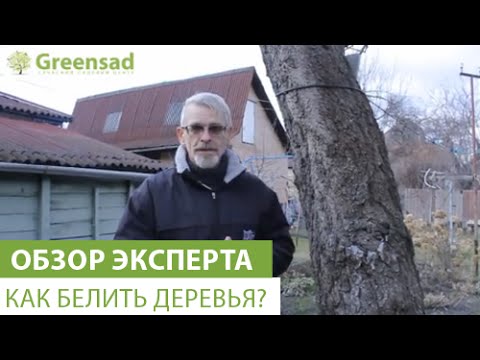

Watch this video on YouTube

